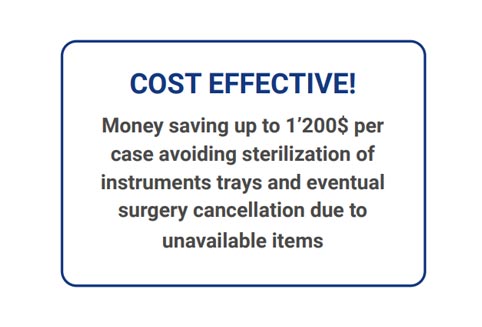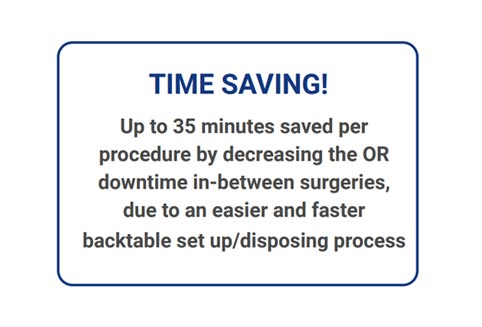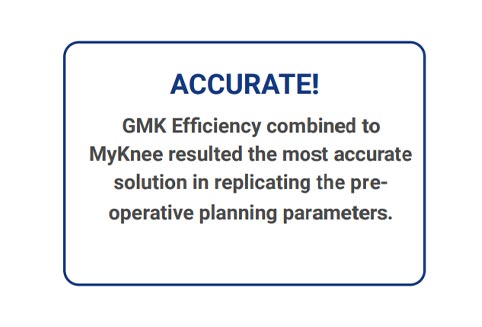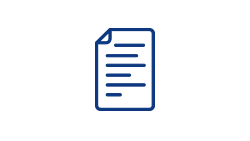
Innovation
that delivers
Healthcare systems around the world are being challenged by ever greater demand against a backdrop of economic pressure.
The default position is that everyone is being challenged to provide evidence of increased benefit at the existing cost or to deliver
the same healthcare benefit at a reduced overall cost.
Medacta is committed to providing orthopaedic solutions that are optimally safe and effective, but also to delivering
sustainability and economic efficiency.
GMK Efficiency is a complete single use instrument solution used to implant the GMK Primary or GMK Sphere. It has been conceived
to optimise instrument management, providing significant benefits in the O.R. and throughout the hospital supply chain.
Following Medacta’s holistic vision, GMK Efficiency is able to deliver innovation to every healthcare stakeholder.
.jpg)
COMPLETE SINGLE USE INSTRUMENTATION
Management of implant-related re-usable surgical instruments is eliminated. The backtable setup and intra-op management is simplified and the O.R. downtime between surgeries can be reduced.
LOWER INFECTION RISK
The use of single-use instrumentation can potentially reduce the risk of non-sterile instrument occurrences.[1] The estimated cost for a single surgical site infection is on average $25,500.[2]
EFFICIENT AND COST-EFFECTIVE
No sterilisation needed.
Time and costs related to instrument checking and collection, washing and sterilisation are eliminated, resulting in significant savings for the hospital. [3] The potential reduction in O.R. turnover time and the optimization of staff management can lead to additional cases during the same surgical session.
ALWAYS READY, STERILE AND BRAND NEW
Surgery cancellation or delay caused by non-sterile, missing, or dysfunctional instruments are prevented. GMK Efficiency is always delivered terminally sterile and, therefore, immediately available also for a last-minute surgery.
REPRODUCIBILE PROCEDURE
Single use instruments are ergonomic, staff-friendly, and brand new for each case. Special medical grade composite technopolymers (MTech) and a precise manufacturing process provides high fatigue and abrasion resistance while granting design versatility. The combination of all these features facilitates more reproducible surgical procedures.

GMK Efficiency is extremely versatile as it can be applied to the comprehensive Medacta knee portfolio of GMK Sphere and GMK Primary.

The optimised size specific layout allows easy selection of the most suitable composition for the surgery, minimising instrument volume and simplifying backtable preparation.

GMK Efficiency used in combination with MyKnee patient-matched instrumentation further enhances its potential benefits.
The O.R. efficiency and savings are combined with potential advantages for the patient, like accurate implant positioning, reduced blood loss and decreased hospitalisation.
GMK Efficiency features a implants size-specific, optimized layout for an effective instrument management. It can be used in conjunction with MyKnee patient-matched guides maximizing its benefits or as a stand-alone solution selecting the GMK Efficiency conventional instruments between the kinematic alignment and the mechanical alignment version to best accommodate surgeon’s philosophy. Additional complement sets are also available to accommodate each surgeon’s own requests and needs, like single-use pin packs, drills, and reamers, or to perform specific surgical steps, like patella resurfacing or tibia extension stems positioning.

MyKnee Patient-Matched platform allows for a precise preoperative planning and an accurate intraoperative execution of the set resections parameters. MyKnee capability of femoral and tibial implants’ size planning perfectly match with GMK Efficiency instrumentation further reducing the operating theatre instruments footprint and optimizing the backtable set up.

MyKnee and GMK Efficiency synergy can be further enhanced by choosing the Efficiency KneePack solution. With this option, Medacta ships MyKnee guides, GMK Efficiency instrumentation and femoral and tibial implants of the planned size all together in a single, light-weight box. Everything the surgeon needs to perform a total knee replacement!

The GMK Efficiency conventional set is available in two different versions: one to be used for the mechanical alignment approach (MA), the other one specific for the kinematic alignment philosophy (KA). This tray includes the dedicated alignment tools to plan the distal femur and proximal tibia resections, and to accordingly position the cutting guides. In addition, a dedicated anterior/posterior reference sizer is available to accurately evaluate the femoral implant size.

GMK Efficiency can be also used in combination with GMK ULTIMATE metal instrumentation in a reusable/single-use hybrid solution. GMK ULTIMATE conventional tray is the Medacta advanced metal set that includes alignment jigs and femoral sizers totally compatible with GMK Efficiency tools. The GMK ULTIMATE Efficiency instrumentation combines all the advantages of modern metal instrumentation with the logistical benefits of a single use set.

GMK Efficiency product range includes also various optional sets allowing the surgeon to perform all the steps of his own surgical practice by means of single-use instruments only. Among the various options, a patella resurfacing tray, different pin packs, calipers and washers sets are available to match every specific surgical practice.
GMK Efficiency clinical and economical benefits in the surgeons’ and hospitals’ daily practice have been evaluated and analyzed in a wide number of published papers. The main findings shown that GMK Efficiency can be:



Below you find the list of some of the main published papers available on GMK Efficiency.
The results of each one of them are displayed and analyzed in the GMK EFFICIENCY Values Dossier:



Our products and surgical procedures are designed to improve patient well-being, facilitate the work of our surgeons and increase the sustainability of the healthcare system by improving efficiency while reducing surgical costs. To further enhance healthcare sustainability in knee procedures, we have developed the GMK Efficiency single-use instrumentation, which offers several benefits to hospitals and outpatient surgical centers in terms of infrastructure and personnel costs .

While we strive for this goal, we maintain a high regard for sustainability. During the development of GMK Efficiency, Medacta analyzed the environmental impact of the product linked to each stage of its life span, throughout its whole life cycle: from manufacturing and usage, to disposal. Such analysis is called life cycle analysis.
Swiss Climate, an independent organization which assists companies in setting up holistic climate strategies and sustainable concepts, carried out this study for both GMK Efficiency and conventional re-usable metal instruments in order to:
To reduce the risk of illness, in Cambodia it is common practice to boil the water over a wood or charcoal fire before drinking it. The wood used for this purpose is obtained from the endangered rainforests in the region, which increases the already very high rate of deforestation even further. Around 20% of Cambodia’s forest cover has been destroyed in the last 20 years. This project provides the local population with ceramic water filters for treating water. It thereby reduces the use of environmentally harmful fuels and cuts CO2 emissions by around 90.000 tons per year.
The Rimba Raya Biodiversity Reserve protects 64,500 hectares of peat swamp forest in southern Borneo, preventing deforestation caused by the palm oil industry and sequestering over 4.5 million tons of CO2 annually. Recognized in September 2020 as the first REDD+ project which contributes to all 17 UN Sustainable Development Goals (SDGs), it also focuses on health and water initiatives for local communities.
Rimba Raya provides access to clean water through filtration systems and wells while offering free medical services and health education. Additionally, it promotes proper sanitation and hygiene practices to enhance community health. Through these efforts, Rimba Raya supports both environmental conservation and the well-being of local populations.
The project guarantees CO2 storage and sustainable management of 7,279 hectares of forest in the Canton of Schwyz. This protects the climate, preserves the Swiss forest biodiversity and allows for the generation of fuel wood for renewable energy production. Thanks to the project, the forest corporation sustainably takes advantage of the fuel wood without reducing the long-term wood supply. Wood is locally processed and used for production of renewable energies in the region. Thanks to project contributions, local biodiversity can be preserved in the forest and protection from natural disasters can be guaranteed.
The system boundaries include the whole life cycle of each analyzed GMK Efficiency instrumentation set and conventional re-usable metal instruments:
The CO2 equivalent emissions for each step of the life cycle were calculated to obtain a measurable value of the environmental impact of each type of instrumentation.

To reduce the risk of illness, in Cambodia it is common practice to boil the water over a wood or charcoal fire before drinking it. The wood used for this purpose is obtained from the endangered rainforests in the region, which increases the already very high rate of deforestation even further. Around 20% of Cambodia’s forest cover has been destroyed in the last 20 years. This project provides the local population with ceramic water filters for treating water. It thereby reduces the use of environmentally harmful fuels and cuts CO2 emissions by around 90.000 tons per year.
The Rimba Raya Biodiversity Reserve protects 64,500 hectares of peat swamp forest in southern Borneo, preventing deforestation caused by the palm oil industry and sequestering over 4.5 million tons of CO2 annually. Recognized in September 2020 as the first REDD+ project which contributes to all 17 UN Sustainable Development Goals (SDGs), it also focuses on health and water initiatives for local communities.
Rimba Raya provides access to clean water through filtration systems and wells while offering free medical services and health education. Additionally, it promotes proper sanitation and hygiene practices to enhance community health. Through these efforts, Rimba Raya supports both environmental conservation and the well-being of local populations.
The project guarantees CO2 storage and sustainable management of 7,279 hectares of forest in the Canton of Schwyz. This protects the climate, preserves the Swiss forest biodiversity and allows for the generation of fuel wood for renewable energy production. Thanks to the project, the forest corporation sustainably takes advantage of the fuel wood without reducing the long-term wood supply. Wood is locally processed and used for production of renewable energies in the region. Thanks to project contributions, local biodiversity can be preserved in the forest and protection from natural disasters can be guaranteed.

The second step of the analysis performed has been carried out through a comparative analysis of the environmental impact in three different scenarios:
The outcomes in terms of CO2 emissions have been encouraging. GMK Efficiency has proven to be much better then the on-loan scenario and in line with the emissions associated with the consignment scenario [6, 7, 8]
To reduce the risk of illness, in Cambodia it is common practice to boil the water over a wood or charcoal fire before drinking it. The wood used for this purpose is obtained from the endangered rainforests in the region, which increases the already very high rate of deforestation even further. Around 20% of Cambodia’s forest cover has been destroyed in the last 20 years. This project provides the local population with ceramic water filters for treating water. It thereby reduces the use of environmentally harmful fuels and cuts CO2 emissions by around 90.000 tons per year.
The Rimba Raya Biodiversity Reserve protects 64,500 hectares of peat swamp forest in southern Borneo, preventing deforestation caused by the palm oil industry and sequestering over 4.5 million tons of CO2 annually. Recognized in September 2020 as the first REDD+ project which contributes to all 17 UN Sustainable Development Goals (SDGs), it also focuses on health and water initiatives for local communities.
Rimba Raya provides access to clean water through filtration systems and wells while offering free medical services and health education. Additionally, it promotes proper sanitation and hygiene practices to enhance community health. Through these efforts, Rimba Raya supports both environmental conservation and the well-being of local populations.
The project guarantees CO2 storage and sustainable management of 7,279 hectares of forest in the Canton of Schwyz. This protects the climate, preserves the Swiss forest biodiversity and allows for the generation of fuel wood for renewable energy production. Thanks to the project, the forest corporation sustainably takes advantage of the fuel wood without reducing the long-term wood supply. Wood is locally processed and used for production of renewable energies in the region. Thanks to project contributions, local biodiversity can be preserved in the forest and protection from natural disasters can be guaranteed.
Another important topic regarding the environmental impact associated with a surgical instruments set is water consumption. Conventional re-usable metal instruments must be washed, disinfected and sterilized after each surgical procedure. This process is highly water consuming: up to 425 liters of clean water are used for every single cleaning cycle[9-11]
The GMK Efficiency instrumentation, instead, is sterilized by means of gamma radiation and each set is delivered to the operating room in sterile, single-use packs. After the surgery is completed, the instruments can be easily disposed without the need of washing or cleaning them. Both these features could help limit the hospital water consumption involved with the total knee arthroplasties performed.

To reduce the risk of illness, in Cambodia it is common practice to boil the water over a wood or charcoal fire before drinking it. The wood used for this purpose is obtained from the endangered rainforests in the region, which increases the already very high rate of deforestation even further. Around 20% of Cambodia’s forest cover has been destroyed in the last 20 years. This project provides the local population with ceramic water filters for treating water. It thereby reduces the use of environmentally harmful fuels and cuts CO2 emissions by around 90.000 tons per year.
The Rimba Raya Biodiversity Reserve protects 64,500 hectares of peat swamp forest in southern Borneo, preventing deforestation caused by the palm oil industry and sequestering over 4.5 million tons of CO2 annually. Recognized in September 2020 as the first REDD+ project which contributes to all 17 UN Sustainable Development Goals (SDGs), it also focuses on health and water initiatives for local communities.
Rimba Raya provides access to clean water through filtration systems and wells while offering free medical services and health education. Additionally, it promotes proper sanitation and hygiene practices to enhance community health. Through these efforts, Rimba Raya supports both environmental conservation and the well-being of local populations.
The project guarantees CO2 storage and sustainable management of 7,279 hectares of forest in the Canton of Schwyz. This protects the climate, preserves the Swiss forest biodiversity and allows for the generation of fuel wood for renewable energy production. Thanks to the project, the forest corporation sustainably takes advantage of the fuel wood without reducing the long-term wood supply. Wood is locally processed and used for production of renewable energies in the region. Thanks to project contributions, local biodiversity can be preserved in the forest and protection from natural disasters can be guaranteed.

Since the market release of GMK Efficiency, Medacta has undertaken to offset the total amount of CO2 equivalent emissions associated with the production and disposal of this single-use instrumentation through the sponsorship of environmental sustainability projects, promoted by Swiss Climate. The aim of these projects is to reduce the CO2 equivalent emissions and encourage the establishment of a healthier and less polluted environment.
To reduce the risk of illness, in Cambodia it is common practice to boil the water over a wood or charcoal fire before drinking it. The wood used for this purpose is obtained from the endangered rainforests in the region, which increases the already very high rate of deforestation even further. Around 20% of Cambodia’s forest cover has been destroyed in the last 20 years. This project provides the local population with ceramic water filters for treating water. It thereby reduces the use of environmentally harmful fuels and cuts CO2 emissions by around 90.000 tons per year.
The Rimba Raya Biodiversity Reserve protects 64,500 hectares of peat swamp forest in southern Borneo, preventing deforestation caused by the palm oil industry and sequestering over 4.5 million tons of CO2 annually. Recognized in September 2020 as the first REDD+ project which contributes to all 17 UN Sustainable Development Goals (SDGs), it also focuses on health and water initiatives for local communities.
Rimba Raya provides access to clean water through filtration systems and wells while offering free medical services and health education. Additionally, it promotes proper sanitation and hygiene practices to enhance community health. Through these efforts, Rimba Raya supports both environmental conservation and the well-being of local populations.
The project guarantees CO2 storage and sustainable management of 7,279 hectares of forest in the Canton of Schwyz. This protects the climate, preserves the Swiss forest biodiversity and allows for the generation of fuel wood for renewable energy production. Thanks to the project, the forest corporation sustainably takes advantage of the fuel wood without reducing the long-term wood supply. Wood is locally processed and used for production of renewable energies in the region. Thanks to project contributions, local biodiversity can be preserved in the forest and protection from natural disasters can be guaranteed.
[1] Siegel G. W., Patel N. N., Milshteyn M. A., Buzas D., Lombardo D. J., Morawa L. G., M.D., Cost Analysis and Surgical Site Infection Rates in Total Knee Arthroplasty Comparing Traditional vs Single-Use Instruments. The Journal of Arthroplasty 30; (2015): 2271-2274.
[2] Stone at al, American Journal of infection control, 2005
[3] Dell’Osso G, Celli F, Bottai V, Bugelli G, Citarelli C, Agostini G, Guido G, Giannotti S Single-Use Instrumentation Technologies in Knee Arthroplasty: State of The Art, Surg Technol Int. 2016 Apr 27;XXVIII. pii: sti28/727.
[4] Survey on European Hospital s and Clinics. Data on file Medacta.
[5] DATA from SWISSCLIMATE Report on GMK Efficiency Carbon Footprint ISO 14044.
[6] The impact of surgery on global climate: a carbon footprinting study of operating theatres in three health systems - A J MacNeil, R Lilywhite, C J Brown - Lancet Planet Health 2017.
[7] DATA from SWISSCLIMATE regarding Insel group in Bern.
[8] Analyse du cycle de vie de différents sets d’ancillaires, Prof. S. Descamps et al., Service d’Orthopédie, Traumatologie, Chirurgie Plastique et Reconstructive, Hôpital Gabriel Montpied, CHU de Clermont-Ferrand.
[9] Getinge 46 Washer Disinfector - Service instructions.
[10] Recommendations for Cleaning, Decontamination and Sterilization of Medacta International Orthopedic Devices.
[11] Priorclave North America Report, 2013. 58 | 59.